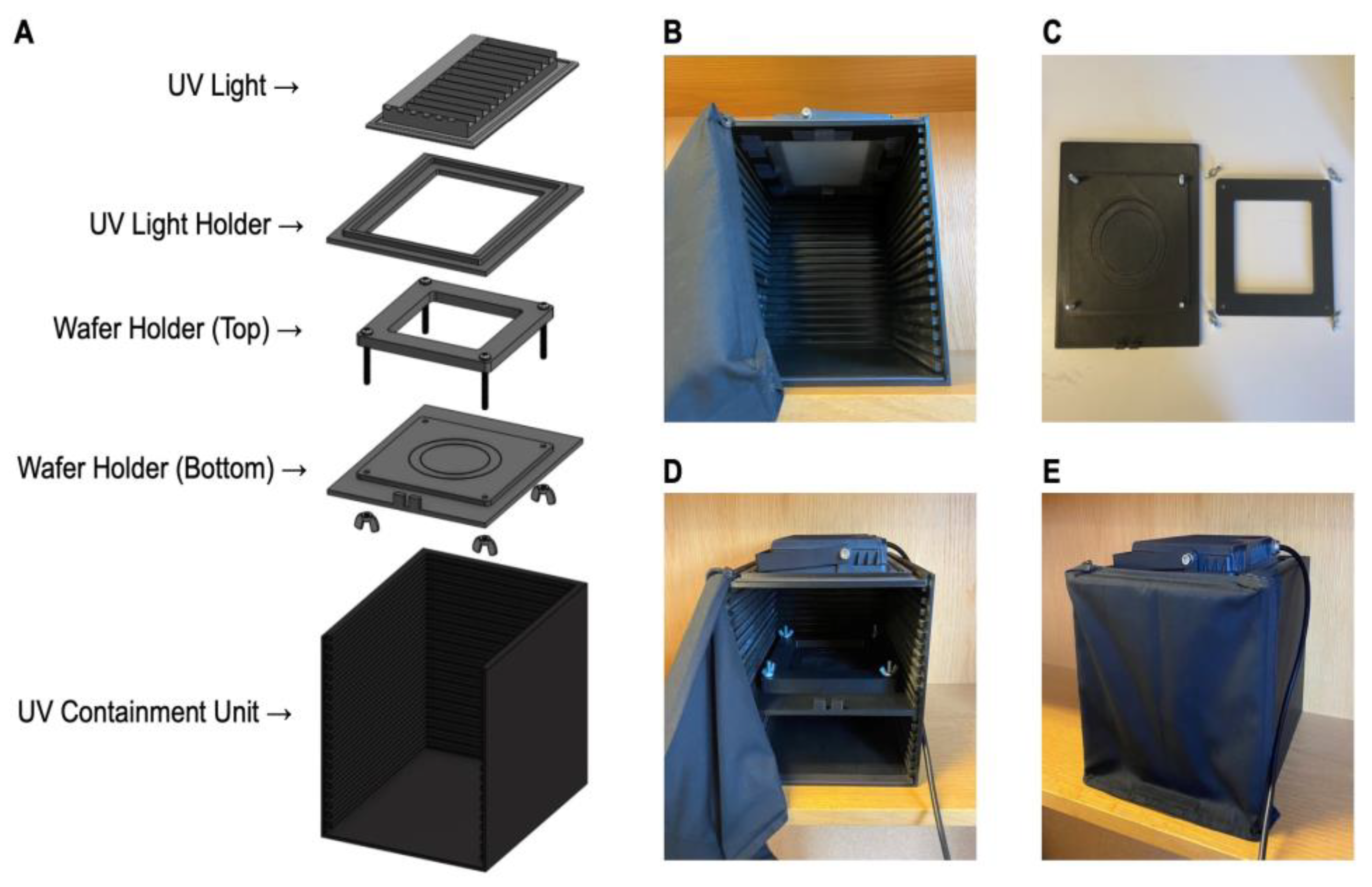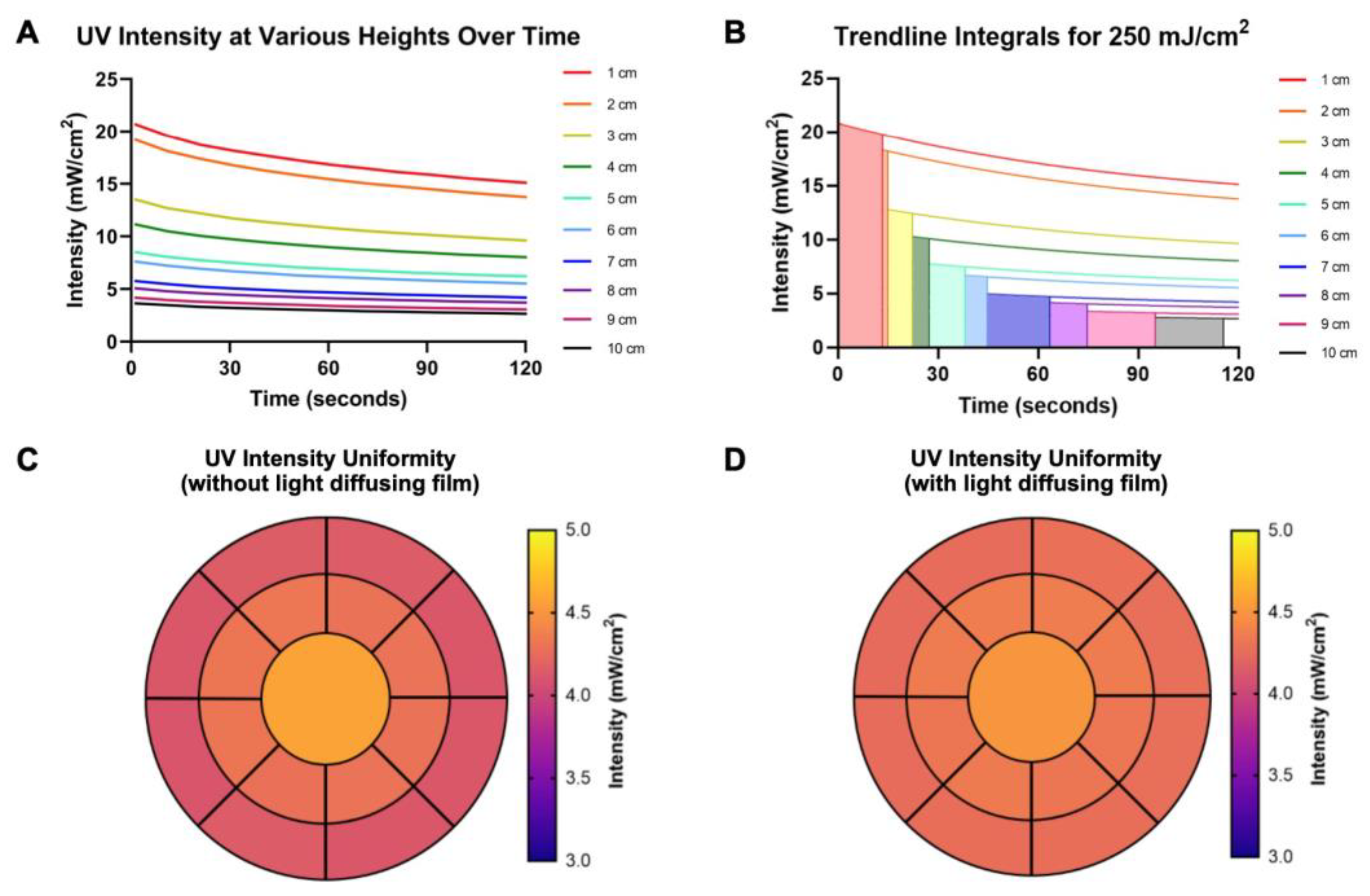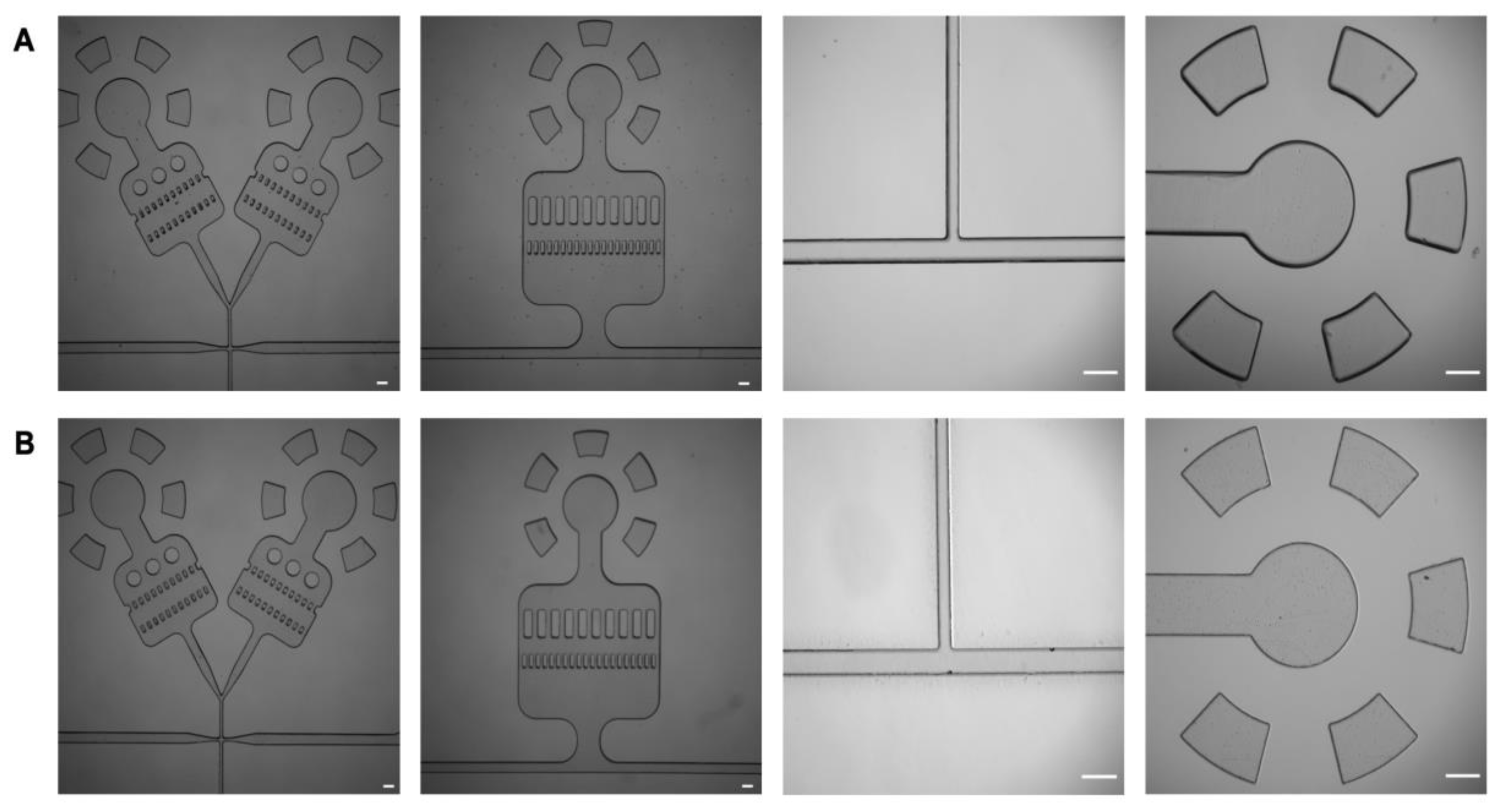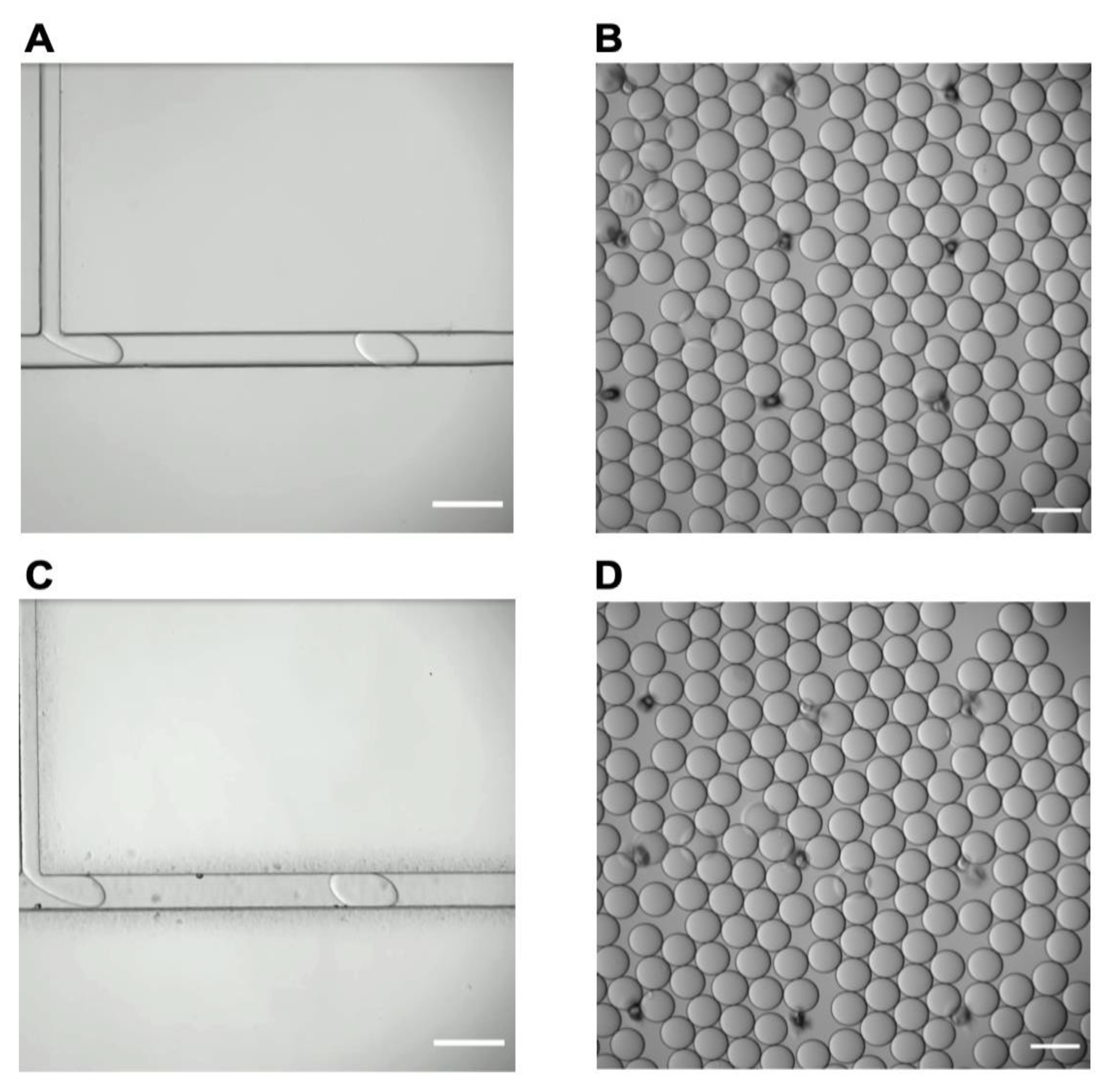A Customizable and Low-Cost Ultraviolet Exposure System for Photolithography
Abstract
1. Introduction
2. Materials and Methods
2.1. UV Lamp Containment Unit
2.2. UV Light Holder
2.3. Wafer Holders
2.4. UV Exposure Calibration
2.5. Microfluidic Droplet Device Fabrication and Testing
3. Results & Discussion
3.1. DUV Light System Fabrication and Assembly
3.2. DUV Light System Validation
3.3. Comparison of Developed Patterns
3.4. Microfluidic Droplet Device Performance Testing
4. Conclusions
Supplementary Materials
Author Contributions
Funding
Institutional Review Board Statement
Informed Consent Statement
Data Availability Statement
Acknowledgments
Conflicts of Interest
References
- Sanati, A.; Esmaeili, Y.; Bidram, E.; Shariati, L.; Rafienia, M.; Mahshid, S.; Parlak, O. Recent advancement in electrode materials and fabrication, microfluidic designs, and self-powered systems for wearable non-invasive electrochemical glucose monitoring. Appl. Mater. Today 2022, 26, 101350. [Google Scholar] [CrossRef]
- Shin, J.H.; Choi, S. Open-source and do-it-yourself microfluidics. Sens. Actuators B Chem. 2021, 347, 130624. [Google Scholar] [CrossRef]
- Luo, C.; Xu, C.; Lv, L.; Li, H.; Huang, X.; Liu, W. Review of recent advances in inorganic photoresists. RSC Adv. 2020, 10, 8385–8395. [Google Scholar] [CrossRef] [PubMed]
- Gundlach, A.M.; Stevenson, J.T.M. The application of photolithography to the fabrication of microcircuits. J. Phys. E Sci. Instrum. 1986, 19, 654. [Google Scholar]
- Yang, W.; Wang, Z.; Yu, T.; Chen, Y.; Ge, Z. Recent advance in cell patterning techniques: Approaches, applications and future prospects. Sens. Actuators A Phys. 2022, 333, 113229. [Google Scholar] [CrossRef]
- Stefano, J.S.; Orzari, L.O.; Silva-Neto, H.A.; de Ataíde, V.N.; Mendes, L.F.; Coltro, W.K.T.; Paixão, T.R.L.C.; Janegitz, B.C. Different approaches for fabrication of lowcost electrochemical sensors. Curr. Opin. Electrochem. 2022, 32, 100893. [Google Scholar] [CrossRef]
- Mir, M.; Dondapati, S.K.; Duarte, M.V.; Chatzichristidi, M.; Misiakos, K.; Petrou, P.; Kakabakos, S.E.; Argitis, P.; Katakis, I. Electrochemical biosensor microarray functionalized by means of biomolecule friendly photolithography. Biosens. Bioelectron. 2010, 25, 2115–2121. [Google Scholar] [CrossRef] [PubMed]
- Gayathri, R.; Kar, S.; Nagai, M.; Tseng, F.-G.; Mahapatra, P.S.; Santra, T.S. Single-cell patterning: A new frontier in bioengineering. Mater. Today Chem. 2022, 26, 101021. [Google Scholar] [CrossRef]
- Handrea-Dragan, I.M.; Botiz, I.; Tatar, A.-S.; Boca, S. Patterning at the micro/nano-scale: Polymeric scaffolds for medical diagnostic and cellsurface interaction applications. Colloids Surf. B Biointerfaces 2022, 218, 112730. [Google Scholar] [CrossRef] [PubMed]
- Yanagawa, F.; Sugiura, S.; Kanamori, T. Hydrogel microfabrication technology toward three dimensional tissue engineering. Regen. Ther. 2016, 3, 45–57. [Google Scholar] [CrossRef] [PubMed]
- Fu, X.; Cai, J.; Zhang, X.; Li, W.-D.; Ge, H.; Hu, Y. Top-down fabrication of shape-controlled, monodisperse nanoparticles for biomedical applications. Adv. Drug Deliv. Rev. 2018, 132, 169–187. [Google Scholar] [CrossRef] [PubMed]
- Ermis, M.; Antmen, E.; Hasirci, V. Micro and Nanofabrication methods to control cell-substrate interactions and cell behavior: A review from the tissue engineering perspective. Bioact. Mater. 2018, 3, 355–369. [Google Scholar] [CrossRef] [PubMed]
- Naggay, B.K.; Frey, K.; Schneider, M.; Athanasopulu, K.; Lorenz, G.; Kemkemer, R. Low-cost photolithography system for cell biology labs. Curr. Dir. Biomed. Eng. 2021, 7, 550–553. [Google Scholar] [CrossRef]
- Naggay, B.; Athanasopulu, K.; Kemkemer, R. Build-Up and Validation of a Low Cost Benchtop Photolithography Tool; Angewandte Chemie, Reutlingen University: Reutlingen, Germany, 2016. [Google Scholar]
- Rizqika, R.; Whulanza, Y.; Charmet, J.; Kiswanto, G.; Soemardi, T.P. Characterization of homemade UV-LED photolithography to realize high aspect ratio channels. AIP Conf. Proc. 2020, 2227, 020010. [Google Scholar]
- Huntington, M.D.; Odom, T.W. A Portable, Benchtop Photolithography System Based on a Solid-State Light Source. Small 2011, 7, 3144–3147. [Google Scholar] [CrossRef] [PubMed]
- Erickstad, M.; Gutierrez, E.; Groisman, A. A low-cost low-maintenance ultraviolet lithography light source based on light-emitting diodes. Lab A Chip 2015, 15, 57–61. [Google Scholar] [CrossRef] [PubMed]
- Pham, Q.L.; Tong, N.A.N.; Mathew, A.; Basuray, S.; Voronov, R.S. A compact low-cost low-maintenance open architecture mask aligner for fabrication of multilayer microfluidics devices. Biomicrofluidics 2018, 12, 044119. [Google Scholar] [CrossRef] [PubMed]
- Beck, A.; Obst, F.; Busek, M.; Grünzner, S.; Mehner, P.J.; Paschew, G.; Appelhans, D.; Voit, B.; Richter, A. Hydrogel Patterns in Microfluidic Devices by Do-It-Yourself UV-Photolithography Suitable for Very Large-Scale Integration. Micromachines 2020, 11, 479. [Google Scholar] [CrossRef] [PubMed]
- Kayaku Microchem SU-8 2000. Available online: https://kayakuam.com/wp-content/uploads/2019/09/SU-82000DataSheet2000_5thru2015Ver4.pdf (accessed on 15 September 2022).
- Kayaku Microchem SU-8 3000. Available online: https://kayakuam.com/wp-content/uploads/2019/09/SU-8-3000-Data-Sheet.pdf (accessed on 15 September 2022).
- Singh Center for Nanotechnology. Available online: https://www.nano.upenn.edu/equipment/amb-3000/ (accessed on 15 September 2022).




| Item | Quantity | Vendor | Cost ($) |
|---|---|---|---|
| 3D Printer PLA | 2 | HATCHBOX | 49.98 |
| Magnetic Tape | 1 | Master Magnetics | 7.69 |
| Black Fabric | 1 | Sedona Design, Inc. | 7.95 |
| UV Lamp | 1 | Everbeam | 48.99 |
| Outlet Timer | 1 | BN-LINK | 30.99 |
| Light Diffusing Film | 1 | Edmund Optics | 45.00 |
| Screws & Wing Nuts | 4 | Hillman | 5.36 |
| Total | $195.96 |
Publisher’s Note: MDPI stays neutral with regard to jurisdictional claims in published maps and institutional affiliations. |
© 2022 by the authors. Licensee MDPI, Basel, Switzerland. This article is an open access article distributed under the terms and conditions of the Creative Commons Attribution (CC BY) license (https://creativecommons.org/licenses/by/4.0/).
Share and Cite
Reynolds, D.E.; Lewallen, O.; Galanis, G.; Ko, J. A Customizable and Low-Cost Ultraviolet Exposure System for Photolithography. Micromachines 2022, 13, 2129. https://doi.org/10.3390/mi13122129
Reynolds DE, Lewallen O, Galanis G, Ko J. A Customizable and Low-Cost Ultraviolet Exposure System for Photolithography. Micromachines. 2022; 13(12):2129. https://doi.org/10.3390/mi13122129
Chicago/Turabian StyleReynolds, David Eun, Olivia Lewallen, George Galanis, and Jina Ko. 2022. "A Customizable and Low-Cost Ultraviolet Exposure System for Photolithography" Micromachines 13, no. 12: 2129. https://doi.org/10.3390/mi13122129
APA StyleReynolds, D. E., Lewallen, O., Galanis, G., & Ko, J. (2022). A Customizable and Low-Cost Ultraviolet Exposure System for Photolithography. Micromachines, 13(12), 2129. https://doi.org/10.3390/mi13122129





